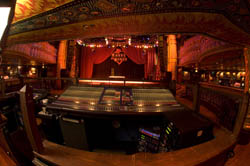Bringing Down The House

- CHICAGO, IL-Looking to create a reputation for consistent quality in its venues across the U.S., the House of Blues established a relationship with Illinois-based db Sound early on. A respected name in sound reinforcement for touring artists, db Sound uses this background to design custom installations for venues such as the House of Blues that compare to that of large tours. What it's done with the House of Blues is to create a sound standard that any size act can rely on, and that all audiences will enjoy.
At the House of Blues Chicago, a Midas Heritage 2000 sits at the front-of-house position, and an Electro-Voice X-Array system provides award-winning sound throughout the decade-old venue.
Harry Witz, CEO of db Sound, started designing sound systems in the House of Blues when it launched a new location in Las Vegas in 1999. Looking for a touring-grade system, he specified the Electro-Voice X-Array in Las Vegas, and based on the success of the installation, others soon followed. For system upgrades to the House of Blues venues in New Orleans and Chicago, he once again relied on X-Arrays, stating that the versatility of the speaker system made it an ideal fit for both despite each venue's unique design. "In New Orleans, it is a stacked system, because that's what worked best for that particular venue," said Witz. "But then it's flown in Chicago, which is a perfect fit."
After another successful install of an X-Array system at a new Anaheim House of Blues venue, EV released the XLC compact line array series and Witz was eager to try it out in the next House of Blues upgrade at its West Hollywood location. The West Hollywood venue already had a sound system in it and was essentially complete, but needed speakers that could throw well in a short distance. "We needed to get something that could spread out quickly," said Witz. "The XLC has a pretty wide dispersion pattern, so that was my choice."
After installing the system for a test run, the response led to a permanent installation. "Everyone ended up thinking it was killer," Witz remarked. "Subsequently, with such a great response, new installs like Cleveland and San Diego have been XLCs as well."
The West Hollywood location has an EV XLC mid-sized line array, with six on each side of the stage, and three X-Line double 18-inch subs per side as well. The system is powered by EV P3000 amplifiers, and the processors are Klark Teknik's Helix DN9848E. Additionally, Midas mixing consoles are standard throughout the House of Blues venues, Witz said, due to its broad acceptance in the industry. The set up has been so successful at the West Hollywood location that it was recently declared "Nightclub of the Year" at the Pollstar Awards, an annual event that recognizes outstanding performance in the concert industry.
With more new House of Blues projects coming up in the next year for db Sound, it is clear that they've created a winning recipe by building sound systems around EV arrays. "There are two portions to a template," Witz explained. "One is that we know there's a certain amount of monitor mixes, a certain amount of channels we need, a certain amount of distribution that we want, a certain amount of coverage in the room that we need to have, and based upon those needs, it wouldn't matter the equipment is-it still requires equipment that will fit that list." Number two, Witz said, is that since a band expects a level of quality from one venue to the next, it is good to have the same thing. "We're trying to provide some sort of consistency," Witz said, while acknowledging the inevitability of innovation. "Of course, as the clock ticks, the technology does change and there might be upgrades that we will do, but for right now, we simply adjust to the venue. The House of Blues has set a standard, and it would be difficult to one-up them."
A daily selection of the top stories for AV integrators, resellers and consultants. Sign up below.
